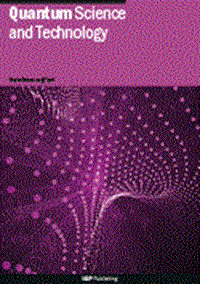在异构模块化量子计算网络架构上分配电路
IF 5.6
2区 物理与天体物理
Q1 PHYSICS, MULTIDISCIPLINARY
引用次数: 0
摘要
我们考虑了量子计算模块的异构网络,这些模块通过贝尔态稀疏连接。跨越这些连接的操作构成了计算瓶颈,与模块内的操作相比,它们可能会给计算增加更多噪音。我们介绍了几种将给定量子电路转化为可在这种网络上实现的量子电路的技术,从而最大限度地减少所需的贝尔态数量。我们将以前关于电路分配的工作扩展到异构网络的情况。一方面,我们将 Andres-Martinez 和 Heunen(2019 Phys. Rev. A 100 032308)的超图方法扩展到任意网络拓扑,并提出使用斯坦纳树来检测和重用公共连接,进一步降低网络内纠缠共享的成本。另一方面,我们将 Wu 等人(2023 Quantum7 1196)的嵌入技术扩展到具有两个以上模块的网络。我们的研究表明,通过仔细权衡,这两种新方法可以结合到一个自动化框架中。我们的建议已付诸实施并进行了基准测试;结果证实,我们的贡献明显改善了上述工作,并补充了它们的不足。本文章由计算机程序翻译,如有差异,请以英文原文为准。
Distributing circuits over heterogeneous, modular quantum computing network architectures
We consider a heterogeneous network of quantum computing modules, sparsely connected via Bell states. Operations across these connections constitute a computational bottleneck and they are likely to add more noise to the computation than operations performed within a module. We introduce several techniques for transforming a given quantum circuit into one implementable on such a network, minimising the number of Bell states required to do so. We extend previous works on circuit distribution to the case of heterogeneous networks. On the one hand, we extend the hypergraph approach of Andres-Martinez and Heunen (2019 Phys. Rev. A 100 032308) to arbitrary network topologies, and we propose the use of Steiner trees to detect and reuse common connections, further reducing the cost of entanglement sharing within the network. On the other hand, we extend the embedding techniques of Wu et al (2023 Quantum7 1196) to networks with more than two modules. We show that, with careful manipulation of trade-offs, these two new approaches can be combined into a single automated framework. Our proposal is implemented and benchmarked; the results confirm that our contributions make noticeable improvements upon the aforementioned works and complement their weaknesses.
求助全文
通过发布文献求助,成功后即可免费获取论文全文。
去求助
来源期刊

Quantum Science and Technology
Materials Science-Materials Science (miscellaneous)
CiteScore
11.20
自引率
3.00%
发文量
133
期刊介绍:
Driven by advances in technology and experimental capability, the last decade has seen the emergence of quantum technology: a new praxis for controlling the quantum world. It is now possible to engineer complex, multi-component systems that merge the once distinct fields of quantum optics and condensed matter physics.
Quantum Science and Technology is a new multidisciplinary, electronic-only journal, devoted to publishing research of the highest quality and impact covering theoretical and experimental advances in the fundamental science and application of all quantum-enabled technologies.
 求助内容:
求助内容: 应助结果提醒方式:
应助结果提醒方式:


